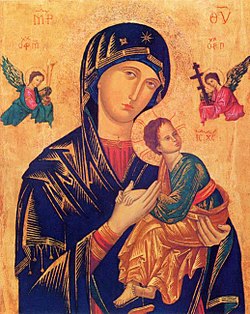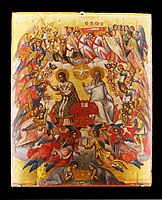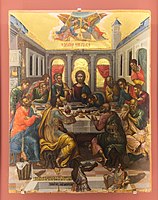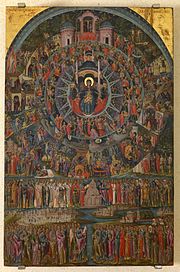Cretan school

Cretan school describes an important school of icon painting, under the umbrella of post-Byzantine art,[1] which flourished while Crete was under Venetian rule during the late Middle Ages, reaching its climax after the fall of Constantinople, becoming the central force in Greek painting during the 15th, 16th and 17th centuries. The Cretan artists developed a particular style of painting under the influence of both Eastern and Western artistic traditions and movements; the most famous product of the school, El Greco, was the most successful of the many artists who tried to build a career in Western Europe, and also the one who left the Byzantine style farthest behind him in his later career.
15th century


There was a substantial demand for Byzantine icons in Europe throughout the Middle Ages and, as a Venetian possession since 1204, Crete had a natural advantage and soon came to dominate the supply. A probable early example is the famous icon of the Virgin in Rome known as Our Mother of Perpetual Help, which was certainly well known in Rome by 1499. At this date there is little to distinguish Cretan work from other Byzantine icons stylistically, and the quality of work is lower than that associated with Constantinople.
This period also saw considerable numbers of wall-paintings in local churches and monasteries - altogether some 850 from the 14th and 15th centuries survive in Crete, far more than from earlier or later periods.[2]
By the late 15th century, Cretan artists had established a distinct icon-painting style, distinguished by "the precise outlines, the modelling of the flesh with dark brown underpaint and dense tiny highlights on the cheeks of the faces, the bright colours in the garments, the geometrical treatment of the drapery, and, finally the balanced articulation of the composition",[3] or "sharp contours, slim silhouettes, linear draperies and restrained movements".[4] The most famous artist of the period was Andreas Ritzos (c. 1421–1492), whose son Nicholas was also well known. Angelos Akotantos, until recently thought to be a conservative painter of the 17th century, is now, after the discovery of a will dated 1436, seen to have been an innovative artist in fusing Byzantine and Western styles, who survived until about 1457, when the will was actually registered. The will was made in anticipation of a voyage to Constantinople; several icons were bequeathed to church institutions, some Catholic but mainly Orthodox, and the disposition of his stock of pattern drawings was carefully specified.[5] Andreas Pavias (d. after 1504) and his pupil Angelos Bizamanos, and Nicholas Tzafuris (d. before 1501) were other leading artists.[6]
Even before the fall of Constantinople there is evidence that leading Byzantine artists were leaving the capital in order to settle in Crete. The migration of Byzantine artists to Crete continued increasingly during the following years and reached its peak after the fall of Constantinople in 1453, when Crete became "the most important centre of art in the Greek world", influencing artistic developments in the rest of the Greek world. Cretan icons were commissioned for monasteries on Mount Athos and elsewhere.[7] Until it fell to the Turks in 1522, the Cretan school was rivalled by the smaller and less significant community of artists in Rhodes.[8] The Venetian archives preserve considerable documentation on the trade of artistic icons between Venice and Crete, which by the end of the 15th century had become one of mass production. There is documentation of a specific order in 1499, of 700 icons of the Virgin, 500 in a Western style, and 200 in Byzantine style. The order was placed with three artists by two dealers, one Venetian and one from mainland Greece, and the time between contract date and delivery was set at only forty-five days. Probably the quality of many such commissioned icons was fairly low, and the dismissive term Madonneri was devised to describe such bulk painters, who later practiced in Italy also, often using a quasi-Byzantine style, and apparently often Greek or Dalmatian individuals. Production of icons at these levels seems to have led to a glut in the market, and in the following two decades there is much evidence that the Cretan trade declined significantly, as the European demand had been reduced.[9] But at the top end of the market Cretan icons were now the finest in the Byzantine world.
16th century
|
About 120 artists can be documented working in Candia (the Venetian name of Chandax, present day Herakleion), in the period 1453–1526, and they had organized a Schuola di San Luca painter's guild, based on the Italian model.[10] The blending of the Eastern and the Western traditions, and a relaxed interchange between Greek Orthodox and Roman Catholic rites led to the "Cretan Renaissance", a golden period for the arts on the island, where both literature and painting flourished. Some of these painters chose to continue the Byzantine tradition of Constantinople, while others were influenced by the masters of the Venetian Renaissance, such as Giovanni Bellini and Titian.[11] Later, Paolo Veronese was to be a particular influence. Works by these masters or copies were in monasteries and churches of the island, while examples of early Netherlandish painting decorated the Catholic churches of Candia or were to be found in the private collections of rich Venetians and Greeks.[12] In particular, Candia contained a large Franciscan church and a large Orthodox monastery, a daughter-house of Saint Catherine's Monastery, both of which had strong collections from their respective traditions.
Contemporary documents refer to two styles in painting: the maniera greca (alla greca, in line with the Byzantine idiom) and the maniera Latina (alla Latina, in accordance with Western techniques), which artists knew and utilized according to the circumstances; as a result some kind of "eclecticism" appeared.[13] Indeed, sometimes both styles could be found in the same icon, the one right next to the other.[12] The fame of the most prominent Cretan painters spread throughout Greece, the Mediterranean and Europe. After the beginning of the 16th century, the Cretan artists once again had more commissions and their works were avidly sought, since they had started to use new motives and to adjust their iconography to the new trends of their era. To an extent quantity was probably replaced by quality compared with the previous century.
16th-century artists

Apart from El Greco, the most famous Cretan artists during the century were Theophanis Strelitzas (Θεοφάνης Στρελίτζας), known as Theophanes the Cretan, Michael Damaskenos (Μιχαήλ Δαμασκηνός), and Georgios Klontzas (Γεώργιος Κλόντζας).[11] Various members of the Lambardos family were also significant artists. Fortunately for art historians, many Cretan painters adopted the practice, perhaps as early as Western painters, of signing their work, which was not a traditional Byzantine practice.[14]
Theophanes the Cretan was a relatively conservative Cretan artist, whose first dated work is from 1527, and all of whose known works were done on the mainland or smaller islands. He was the most important Greek wall painter of his day, incorporating some Western iconographic and stylistic elements, but remaining essentially Byzantine in spirit.
The intellectual and artistic personality of the young El Greco was formed in this artistic environment. In 1563, at the age of twenty-two, El Greco was described in a document as a "master" ("maestro Domenigo"), meaning he was already an enrolled master of the local guild, presumably in charge of his own workshop.[15] He left for Venice a few years later, and never returned to Crete. His Dormition of the Virgin, of before 1567 in tempera and gold on panel (61.4 × 45 cm, Holy Cathedral of the Dormition of the Virgin, Hermoupolis, Syros) was probably created near the end of El Greco's Cretan period. The painting combines post-Byzantine and Italian Mannerist stylistic and iconographic elements, and incorporates stylistic elements of the Cretan school.
|
During the second half of the 16th century, many Cretan artists went to Venice, in the hope of gaining commissions and recognition. Unlike El Greco, the other Cretan painters who moved there did not substantially alter their styles or working methods. They simply incorporated more Italian motifs into a consistent Byzantine framework. Jonathan Brown provides a perceptive analysis of the ways that El Greco distinguished himself from other Cretan artists active in Venice, while Richard Mann argues that "none of these painters accepted Renaissance ideas about the relevance of change to the creation of art works".[16] Michael Damaskenos returned to Crete after three years, and remained there for the rest of his life.
17th century
Georgios Klontzas (1530-1608)
Theodore Poulakis (1622-1692)
The 1600s were characterized as the final period of the Cretan school. The movement featured many artists. The late Cretan school was characterized by prototypes set forth by Michael Damaskinos and Georgios Klontzas. During that period Damaskinos's Beheading of John the Baptist and the Stoning of Stephen were copied by countless Cretan artists. Some included Philotheos Skoufos.[17]
Georgios Klontzas was another Cretan painter copied by many artists of the late Cretan school. Both his In Thee Rejoiceth and his The Last Judgment set the standard for painters of the late Cretan school. Theodore Poulakis was a prominent member of the late Cretan school. His version of Klontzas's painting was also called In Thee Rejoiceth. Both paintings are very similar. Many other painters also created their own version of Klontzas's In Thee Rejoiceth.[18]
The Last Judgement was covered by artists of the Greek-Italian Byzantine style. Klontzas created his own unique version of the painting. Klontzas's Last Judgment was copied by artists of the late Cretan school. Notable versions include Moskos's Last Judgment and Kavertzas's Last Judgment.[19]
One of the most important artistic advancements of the late Cretan school was the work of Ieremias Palladas, a Sinaitic monk. His painting of Catherine of Alexandria, in Saint Catherine's Monastery, was copied by numerous contemporary artists and has served as a prototype for the depiction of the saint into modern times. Painters of the late Cretan school also created their own version of the Crucifixion. Notable version were Ioannis Moskos's Crucifixion and Georgios Markazinis's Crucifixion.[20]

Another major representative of the Cretan school during the 17th century was famous Greek painter Emmanuel Tzanes, 130 of his works survived. Cretan icon painters continued to flourish, until the mid-century. Venetian art was not the only influence of the Cretan school. The late Cretan school was characterized by the influence of flemish engravings namely that of engraver Jan Sadeler I. Sadeler had a workshop in Venice. His work influenced Konstantinos Tzanes and Georgios Markazinis.
The Ottoman Turks occupied all the island except for Candia, which finally fell after twenty years of siege in 1669.[21] After the Ottoman occupation of Crete, the centre of Greek painting moved to the Ionian Islands, which remained under Venetian rule until the Napoleonic Wars. A new artistic movement was created called the Heptanese school which was mostly influenced by Western European artistic trends. Many Cretan artists migrated to the Heptanese or Western Europe to enjoy the artistic freedom. Few artists continued to flourish in Crete after the occupation. Some of them were Michael Prevelis, Ioannis Kornaros and Georgios Kastrofylakas. A successive occupation of the Ionian islands by the French and the British allowed the Heptanese to remain the centre of Greek art until the independence of Greece in 1830.
Research
The Institute of Neohellenic Research published three encyclopaedias outlining the records of countless artists from the fall of the Byzantine Empire until the establishment of modern Greece. It is the first time in history Greek painters were listed on this scale and magnitude. The work resembles Giorgio Vasari's Lives of the Most Excellent Painters, Sculptors, and Architects and Bernardo de' Dominici's Vite dei Pittori, Scultori, ed Architetti Napolitani.[17]
The books feature thousands of paintings, frescos, and other artistic works. The encyclopaedias feature hundreds of painters. The three volumes are currently only available in Greek and entitled Έλληνες Ζωγράφοι μετά την Άλωση (1450-1830) or Greek Painters After the Fall (1450-1830). Eugenia Drakopoulou and Manolis Hatzidakis were the major contributors. The volumes were published in 1987, 1997, and 2010. The books feature many artists from the Cretan school or Greek Renaissance period. Drakopoulou continues her research with the institute until today.[22][23]
The program's purpose is to build an archive of Greek painters after the fall of Constantinople (1450-1830). It features biographical details and an index of artistic works. The Institute of Neohellenic Research catalogues portable icons, church frescoes, and or any other artistic works. This is the first time in history a systematic record was accumulated in Greece representing the period.[24]
Gallery
- St George by Angelos Akotantos (15th century)
- Two Scenes from the Life of St John the Divine by Andreas Ritzos (15th century) Benaki Museum
- Triptych by Andreas Ritzos
- St George Dragon Slayer by Georgios Klontzas (16th)
- Crucifixion by Emmanuel Lambardos (17th)
- Archangel Michael by Theodoros Poulakis (17th)
- Nativity of Christ by Theodoros Poulakis
- St Mark the Evangelist by Emmanuel Tzanes (17th)
- St Theodora by Emmanuel Tzanes
- Resurrection by Elias Moskos (17th)
- Martyrdom of Saint Stephen by Filotheos Skoufos (17th)
- Mary Magdalene by Konstantinos Tzanes (17th)
See also
| Part of a series on the |
| History of Greek art |
|---|
 |
Citations
- ^ Spratt, Emily L. (2012). "Toward a Definition of 'Post-Byzantine' Art: The Angleton Collection at the Princeton University Art Museum". Record of the Art Museum, Princeton University. 71/72: 2–19. JSTOR 24416383.
- ^ Manolis Chatzidakis, in From Byzantium to El Greco, p.42, Athens 1987, Byzantine Museum of Arts
- ^ Nano Chatzidakis, in From Byzantium to El Greco, p.49, Athens 1987, Byzantine Museum of Arts
- ^ Anne Met-Graavgard in Post-Byzantine Art, Grove Art Online, accessed January 31, 2008
- ^ Robin Cormack; Painting the Soul; pp. 182-191; 1997; Reaktion Books, London; ISBN 1-86189-001-X. For the older view, see D. Talbot-Rice, Byzantine Art
- ^ Manolis Chatzidakis in The Icon, 1982, Evans Brothers Ltd, London, p. 311-12, ISBN 0-237-45645-1
- ^ Nano Chatzidakis, op cit, p. 48
- ^ Robin Cormack in Byzantium to El Greco, p.27, Athens 1987, Byzantine Museum of Arts
- ^ Maria Constantoudaki-Kitromilides in From Byzantium to El Greco, p.51-2, Athens 1987, Byzantine Museum of Arts
- ^ Manolis Chatzidakis in The Icon, 1982, Evans Brothers Ltd, London, p. 310, ISBN 0-237-45645-1
- ^ a b M. Tazartes, El Greco, 23-24
- ^ a b M. Lambraki-Plaka, El Greco—The Greek
- ^ M. Lambraki-Plaka, El Greco-The Greek, 40-41
* M. Tazartes, El Greco, 23-24 - ^ David Talbot-Rice, Byzantine Art, 3rd edn 1968, Penguin Books Ltd, p. 384. See also Cormack, 1997, op cit., pp.172-4 & passim
- ^ N.M. Panayotakis, The Cretan Period of Doménicos, 29
- ^ J. Brown, El Greco and Toledo, 76-78
* R.G. Mann, Tradition and Originality in El Greco's Work, 88 - ^ a b Hatzidakis, Manolis (1987). Έλληνες Ζωγράφοι μετά την Άλωση (1450-1830). Τόμος 1: Αβέρκιος - Ιωσήφ [Greek Painters After the Fall of Constantinople (1450-1830). Volume 1: Averkios - Iosif]. Athens: Center for Modern Greek Studies, National Research Foundation. pp. 241–254. hdl:10442/14844. ISBN 960-7916-01-8.
- ^ Speake, Graham (2021). Georgios Klontzas Encyclopedia of Greece and the Hellenic Tradition. London And New York: Rutledge Taylor & Francis Group. p. 893. ISBN 9781135942069.
- ^ Siopis, Ioannis (2016). Το Θέμα της Δευτέρας Παρουσίας στις εικόνες [A Detailed History of the Second Coming (Last Judgment) in Greek Paintings (Greek)] (PDF). Thessaloniki, Greece: Aristotle University of Thessaloniki School of Philosophy Division of Archaeology and History. pp. 51–53.
- ^ Vafea, Flora (2017). The Astronomical Instruments in Saint Catherine's Iconography at the Holy Monastery of Sinai The Almagest Volume 8, Issue 2. Paris, France: University of Paris. pp. 85–106. doi:10.1484/J.ALMAGEST.5.114932.
- ^ X. Papaefthimiou, Popular Aspects of the Greek Iconography Archived 2012-05-24 at archive.today
- ^ Hatzidakis, Manolis & Drakopoulou, Eugenia (1997). Greek Painters After the Fall (1450-1830) Volume B. Athens, GR: Center for Modern Greek Studies E.I.E. pp. 10–15.
- ^ *Drakopoulou, Eugenia (2010). Greek Painters After the Fall (1450-1830) Volume C. Athens, GR: Center for Modern Greek Studies E.I.E. pp. 1–20.
- ^ Eugenia Drakopoulou (August 15, 2021). "Χριστόδουλος Καλλέργης (Καλέργης)". Institute for Neohellenic Research. Retrieved August 15, 2021.
References
General
- Various authors, From Byzantium to El Greco, Athens 1987, Byzantine Museum of Arts
- Chatzidakis, Manolis, in The Icon, 1982, Evans Brothers Ltd, London, 1981, ISBN 0-237-45645-1
- Cormack, Robin (1997). Painting the Soul; Icons, Death Masks and Shrouds. Reaktion Books, London.
- David Talbot-Rice, Byzantine Art, 3rd edn 1968, Penguin Books Ltd
- Hatzidakis, Manolis (1987). Έλληνες Ζωγράφοι μετά την Άλωση (1450-1830). Τόμος 1: Αβέρκιος - Ιωσήφ [Greek Painters After the Fall of Constantinople (1450-1830). Volume 1: Averkios - Iosif]. Athens: Center for Modern Greek Studies, National Research Foundation. hdl:10442/14844. ISBN 960-7916-01-8.
- Hatzidakis, Manolis; Drakopoulou, Evgenia (1997). Έλληνες Ζωγράφοι μετά την Άλωση (1450-1830). Τόμος 2: Καβαλλάρος - Ψαθόπουλος [Greek Painters After the Fall of Constantinople (1450-1830). Volume 2: Kavallaros - Psathopoulos]. Athens: Center for Modern Greek Studies, National Research Foundation. hdl:10442/14088. ISBN 960-7916-00-X.
- Drakopoulou, Evgenia (2010). Έλληνες Ζωγράφοι μετά την Άλωση (1450-1830), Τόμος 3: Αβέρκιος - Ιωσήφ (Συμπληρώσεις-Διορθώσεις) [Greek Painters After the Fall of Constantinople (1450-1830). Volume 3: Averkios - Iosif (Addenda-Corrigenda)]. Athens: Center for Modern Greek Studies, National Research Foundation. hdl:10442/14845. ISBN 978-960-7916-94-5.
- Voulgaropoulou, Margarita (2020). "From Domestic Devotion to the Church Altar: Venerating Icons in Late Medieval and Early Modern Adriatic". Religions. 10 (6): 390. doi:10.3390/rel10060390.
El Greco
- Bray, Xavier; El Greco; 2004; National Gallery Company, London (dist Yale UP);ISBN 1-85709-315-1
- Brown, Jonathan (1982). "El Greco and Toledo". El Greco of Toledo (catalogue). Little Brown. ASIN B-000H4-58C-Y.
- Lambraki-Plaka, Marina (1999). El Greco-The Greek. Kastaniotis. ISBN 960-03-2544-8.
- Mann, Richard G. (2002). "Tradition and Originality in El Greco's Work" (PDF). Journal of the Rocky Mountain. 23. The Medieval and Renaissance Association: 83–110. Archived from the original (PDF) on 2006-09-06. Retrieved 2006-12-12.
- Panayotakis, Nikolaos M. (1986). "The Cretan Period of the Life of Doménicos Theotocópoulos". Festschrift in Honor of Nikos Svoronos, Volume B. Crete University Press.
External links
- National Gallery of Athens
- Nano Hatzidakis: Velimezis Icon Collection
- Giorgios Klontzas icon in Philadelphia
- The Origins of El Greco: Icon Painting in Venetian Crete Exhibition in NY, 2009–10
- The New York Times Art Review: 'The Origins of El Greco' Saints at a Cultural Crossroads
- Byzantium: Faith and Power (1261–1557), an exhibition catalogue from The Metropolitan Museum of Art (fully available online as PDF), which contains material on the Cretan school



















